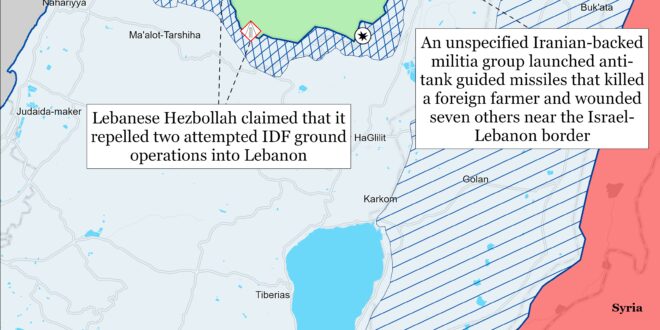Iran reportedly requested Sudanese permission to establish a permanent naval base on the Red Sea coast, which would support Iranian out-of-area naval operations and attacks on international shipping. The Wall Street Journal reported the Iranian request on March 3, citing a senior Sudanese intelligence official.[i] Ahmad Hasan Mohamed—an intelligence adviser to the Sudanese military leader—said that Iran offered “a helicopter-carrying warship” in exchange for Sudan allowing Iran to establish the base. Mohamed stated that Iran wanted the base to gather intelligence on maritime traffic around the Suez Canal and Israel and to station warships at the base. The Wall Street Journal report is consistent with Iranian leaders advocating for building a naval base along the east African coast in recent years.[ii] Mohamed added that Sudan rejected the Iranian request. Both the Iranian and Sudanese foreign affairs ministries have refuted the Wall Street Journal report.[iii] The report follows Sudanese Armed Forces-affiliated Foreign Affairs Minister Ali al Sadiq Ali traveling to Tehran and meeting with senior Iranian officials in early February.[iv]
The Iranian request to establish a naval base in Sudan is part of growing military cooperation between the two countries. Western media previously reported in January that Iran had recently supplied the Sudanese Armed Forces with Mohajer-6 multirole drones.[v] The Iranian effort to establish a naval base likely reflects how Tehran views its defense exports as a means of facilitating the expansion of its overall military influence abroad.
Iran may be attempting to compete with other rival Gulf Arab states in Sudan. The United Arab Emirates is the main backer of the Rapid Support Forces (RSF) owing to various ties between the RSF head (Hemedti) and the emirates.[vi] Abu Dhabi has invested in Sudan as part of its larger strategic effort to expand its influence along the Red Sea with friendly states and client ports.[vii] The United Arab Emirates has funded and supplied the RSF with weapons and used neighboring Chad as a logistics hub for these efforts.[viii]
Key Takeaways:
- Iran: Iran reportedly requested Sudanese permission to establish a permanent naval base on the Red Sea coast, which would support Iranian out-of-area naval operations and attacks on international shipping.
- Northern Gaza Strip: Palestinian fighters defended against Israeli clearing operations in the northern and central Gaza Strip.
- Southern Gaza Strip: Israeli forces continued conducting clearing operations around northern Khan Younis.
- Negotiations: Hamas reportedly made the return of civilians to the northern Gaza Strip a priority in ceasefire negotiations with Israel.
- Iraq: Former Iraqi Parliament Speaker Mohammad al Halbousi discussed unspecified bilateral cooperation with US Ambassador to Iraq Alina Romanowski and other US officials.
- Yemen: The Houthis launched anti-ship missiles that damaged the Liberian-flagged MSC Sky II commercial vessel in the Gulf of Aden. The Houthi military spokesperson claimed that the group launched an unspecified number of anti-ship ballistic missiles and drones targeting US warships in the Red Sea.
- Southern Lebanon and Golan Heights: Iranian-backed militias, including Lebanese Hezbollah, have conducted at least seven attacks from southern Lebanon into northern Israel.
- West Bank: Israeli media reported that Shin Bet arrested four “ISIS-inspired” Palestinians who planned to attack the IDF near Hebron.
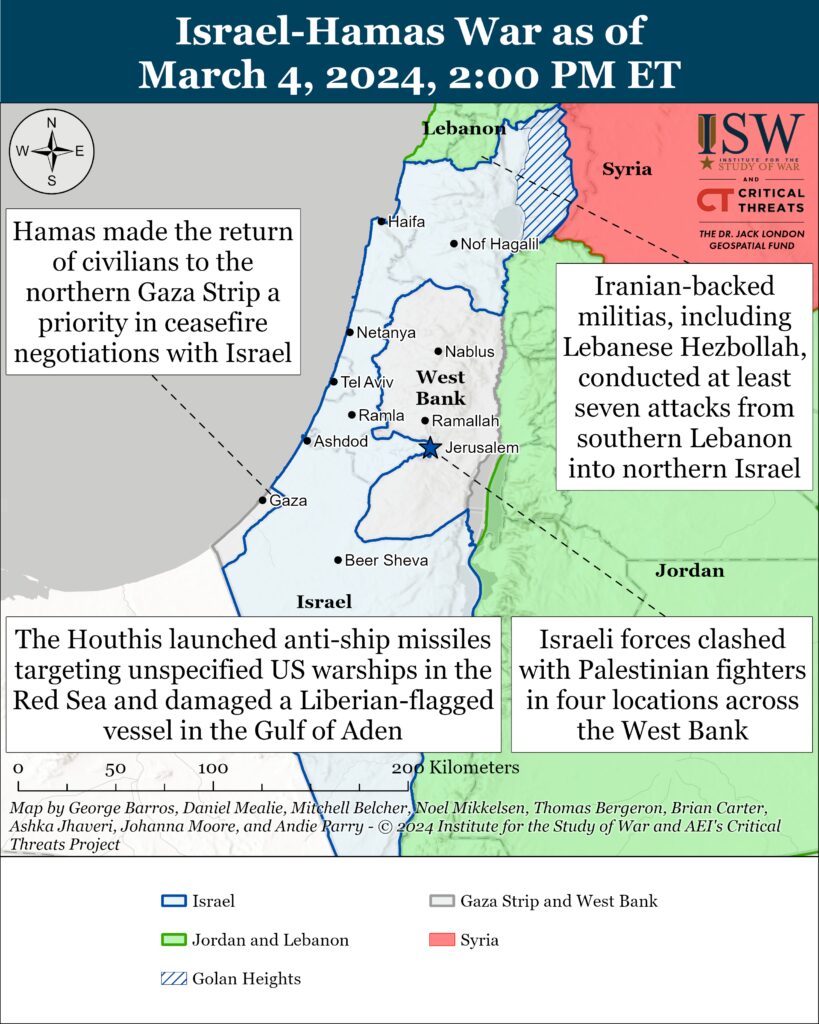
Gaza Strip
Axis of Resistance campaign objectives:
Erode the will of the Israeli political establishment and public to launch and sustain a major ground operation into the Gaza Strip
Degrade IDF material and morale around the Gaza Strip.Palestinian fighters defended against Israeli clearing operations in the northern and central Gaza Strip on March 4. Hamas published footage of its fighters firing mortars and rocket-propelled grenades (RPG) targeting Israeli forces advancing in Tal al Hawa neighborhood, southern Gaza City.[ix] Hamas fighters also fired an anti-tank RPG targeting Israeli armor south of Tal al Hawa on March 4.[x] These attacks follow the Israel Defense Forces (IDF) concluding a two-week-long operation to reclear Zaytoun neighborhood in southeastern Gaza City of Hamas fighters.[xi] Several other Palestinian militias attacked Israeli forces and military equipment across the northern Gaza Strip, including in eastern Jabalia.[xii]
The IDF Nahal Brigade (162nd Division) killed 15 Palestinian fighters using aerial, sniper, and tank fire in the central Gaza Strip.[xiii] The al Aqsa Martyrs’ Brigades, which is the self-proclaimed military wing of Fatah and aligned with Hamas in the war, mortared Israeli armor in the central Gaza Strip.[xiv]
Israeli forces continued conducting clearing operations around northern Khan Younis on March 4. The IDF published details of an operation its forces conducted in the last few days in Hamad neighborhood in northwestern Khan Younis, which the IDF had not entered until March 3.[xv] Two IDF brigades surrounded the neighborhood before Israeli special operations forces (SOF) raided the area. Israeli forces found weapons storage facilities and other unspecified infrastructure belonging to senior Hamas officials. An IDF intelligence assessment concluded that Palestinian fighters retreated from other areas in Khan Younis to hide in Hamad. Israeli forces detained about 80 Palestinians, including members of Hamas and PIJ, in Hamad.[xvi] The IDF Bislamach Brigade continued clearing operations in the Qarara area in northern Khan Younis, where Hamas’ local battalion remains combat effective.[xvii]
Israeli forces clashed with Palestinian fighters in several other sectors of Khan Younis on March 4. Hamas fighters returned from areas of fighting in al Amal neighborhood in western Khan Younis and reported attacks targeting Israeli armor and personnel.[xviii] Hamas fighters also captured two IDF drones in the area through unspecified means.[xix] The al Aqsa Martyrs’ Brigades reported that its fighters clashed with Israeli forces in eastern Khan Younis.[xx] The militia also mortared Israeli vehicles near Hamad.[xxi]

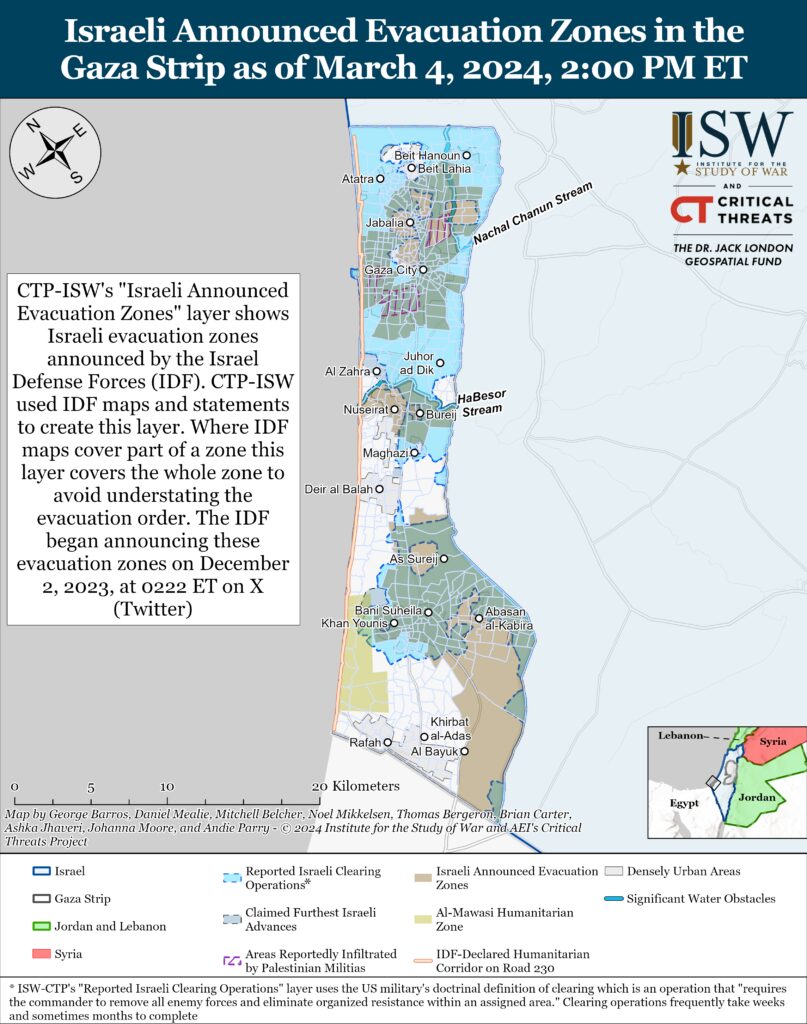
Hamas reportedly made the return of civilians to the northern Gaza Strip a priority in ceasefire negotiations with Israel.[xxii] An Israeli official and an unidentified source familiar with the matter told Axios that Egyptian and Qatari mediators conveyed Hamas’ readiness to reduce the number of Palestinian prisoners whom Israel would release as part of a possible ceasefire agreement. The mediators added, however, that Hamas would instead require the IDF to allow civilians to return to the northern Gaza Strip and that Israel allow more aid into the area. Israeli negotiators were “surprised [by] how important the issue is to Hamas.”[xxiii] Hamas presented the issue of Palestinians returning to the north as a humanitarian one. Axios reported that Israel is concerned that Hamas could rebuild itself as a governing body if Palestinians are allowed to return to the north, which would undermine the Israeli war objective of destroying Hamas. Over one million Palestinians living in the northern Gaza Strip have been displaced due to Israeli military operations.
Hamas could use the return of civilians to the north to bring its own fighters back into the area. CTP-ISW has previously assessed that Hamas is trying to reconstitute its military capabilities and rebuild its governance system in the northern Gaza Strip. An Israeli Army Radio correspondent reported in early February that Palestinian fighters are hiding among civilians in humanitarian shelters to evade capture and facilitate infiltration in the northern Gaza Strip.[xxiv] Israeli forces have identified Palestinian fighters attempting to hide among civilians to disguise their movement elsewhere in the Gaza Strip as well.[xxv] Hamas retains a command structure in the northern Gaza Strip that is attempting to reconstitute Hamas cells.[xxvi] The IDF has explicitly conducted operations to prevent Hamas fighters from infiltrating Gaza City from the southern Gaza Strip.[xxvii]
An Israeli Arab journalist reported on March 4 that unspecified Palestinian clans in the Gaza Strip have pledged their allegiance to the Palestinian Authority (PA).[xxviii] The clans rejected Israel’s post-war plan for administering the Gaza Strip, which the PA has itself criticized as well.[xxix] The journalist claimed that the PA urged these clans not to engage the IDF, including with regard to facilitating the distribution of humanitarian aid.[xxx]
This reported alignment follows the PA and the Palestinian Liberation Organization (PLO) indicating that they may reform themselves and are trying to unify Palestinian factions, including Hamas. PA Prime Minister Mohammad Shtayyeh announced his cabinet’s resignation in late February amid calls for leadership changes within the PA.[xxxi] The PLO separately attended an intra-Palestinian meeting in Moscow on February 29 to discuss the formation of a new Palestinian government.[xxxii]
Palestinian militias conducted two indirect fire attacks from the Gaza Strip targeting southern Israel on March 4.[xxxiii] The IDF Nahal Brigade (162nd Division) identified PIJ fighters that fired rockets from the central Gaza Strip targeting towns in southern Israel on March 2.[xxxiv] Israeli forces directed an airstrike targeting the PIJ fighters.
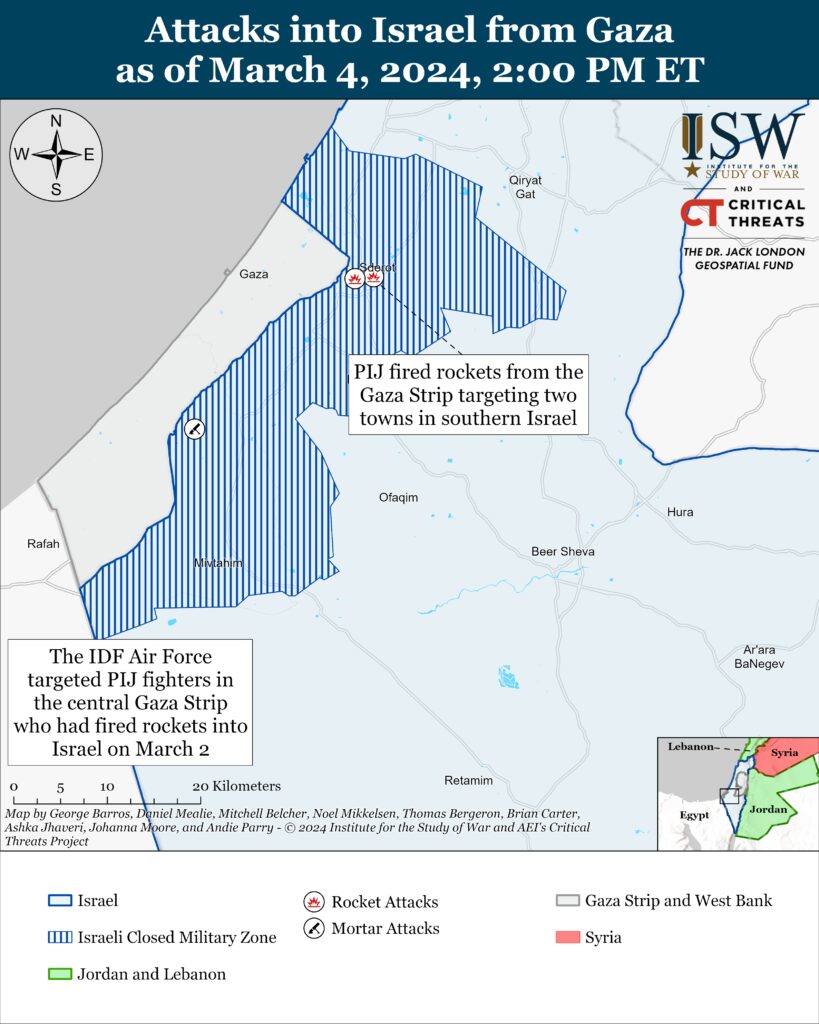
Recorded reports of attacks; CTP-ISW cannot independently verify impact.
West Bank
Axis of Resistance campaign objectives:
Draw IDF assets and resources toward the West Bank and fix them thereIsraeli forces clashed with Palestinian fighters in four locations across the West Bank on March 4.[xxxv] The al Aqsa Martyrs’ Brigades claimed IED and small arms attacks targeting Israeli forces near Tubas, Tulkarm, Qalqilya, and Ramallah.[xxxvi] Hamas and PIJ claimed attacks targeting Israeli forces in Tubas on March 4 as well.[xxxvii]
Israeli media reported on March 4 that Shin Bet arrested four “ISIS-inspired” Palestinians who planned to attack the IDF near Hebron.[xxxviii] Shin Bet reported that the four individuals assembled 100 IEDs and received training from ISIS cells abroad. ISIS previously called for attacks targeting Israel in January 2020 and October 2023.[xxxix] ISIS also claimed two terror attacks targeting Israeli civilians in March 2022.[xl]
The IDF Army Radio reported that unspecified senior Israeli officials warned that a possible escalation in violence in the West Bank during Ramadan could halt IDF operations in Gaza Strip.[xli] The unspecified source said that a violent escalation could force the IDF to transfer forces from the Gaza Strip to the West Bank.
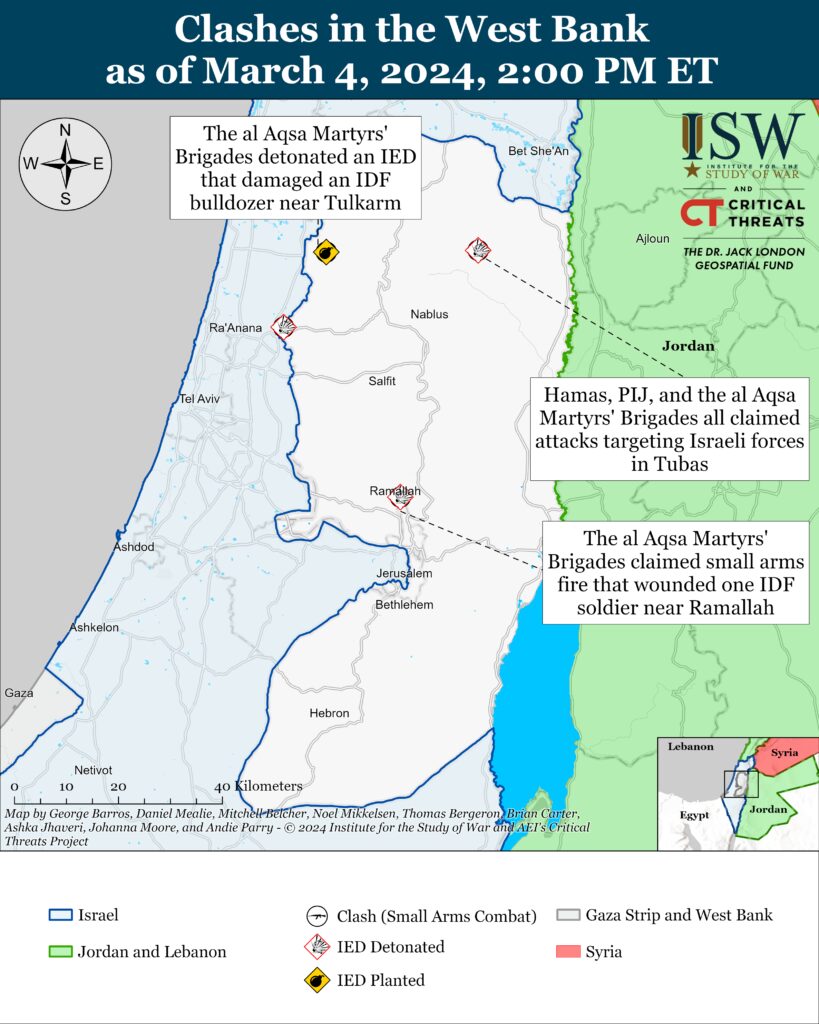
This map is not an exhaustive depiction of clashes and demonstrations in the West Bank.
Southern Lebanon and Golan Heights
Axis of Resistance campaign objectives:
Draw IDF assets and resources toward northern Israel and fix them there
Set conditions for successive campaigns into northern IsraelIranian-backed militias, including Lebanese Hezbollah, have conducted at least seven attacks from southern Lebanon into northern Israel since CTP-ISW’s last data cutoff on March 3. Hezbollah claimed that it detonated IEDs and fired artillery to repel Israeli forces attempting to enter Lebanon at two locations along the Israel-Lebanon border on March 4.[xlii] CTP-ISW cannot verify that the incident occurred. The IDF has not acknowledged any incident. An unspecified Iranian-backed militia group separately launched anti-tank missiles that killed a foreign farm worker and wounded seven others in Margaliot, Israel.[xliii]
Israel conducted airstrikes targeting the Hezbollah-affiliated Islamic Health Organization Civil Defense in southern Lebanon following the attack in Margaliot.[xliv] Hezbollah acknowledged that members of the civil defense organization died in the airstrike.[xlv]
Hezbollah Deputy Secretary General Naim Qassem warned the IDF against “expanding the campaign into Lebanon” on March 4.[xlvi] Qassem stated that Israel ”will find itself facing an upgraded version of the 2006 war” if Israeli forces enter Lebanon.[xlvii]
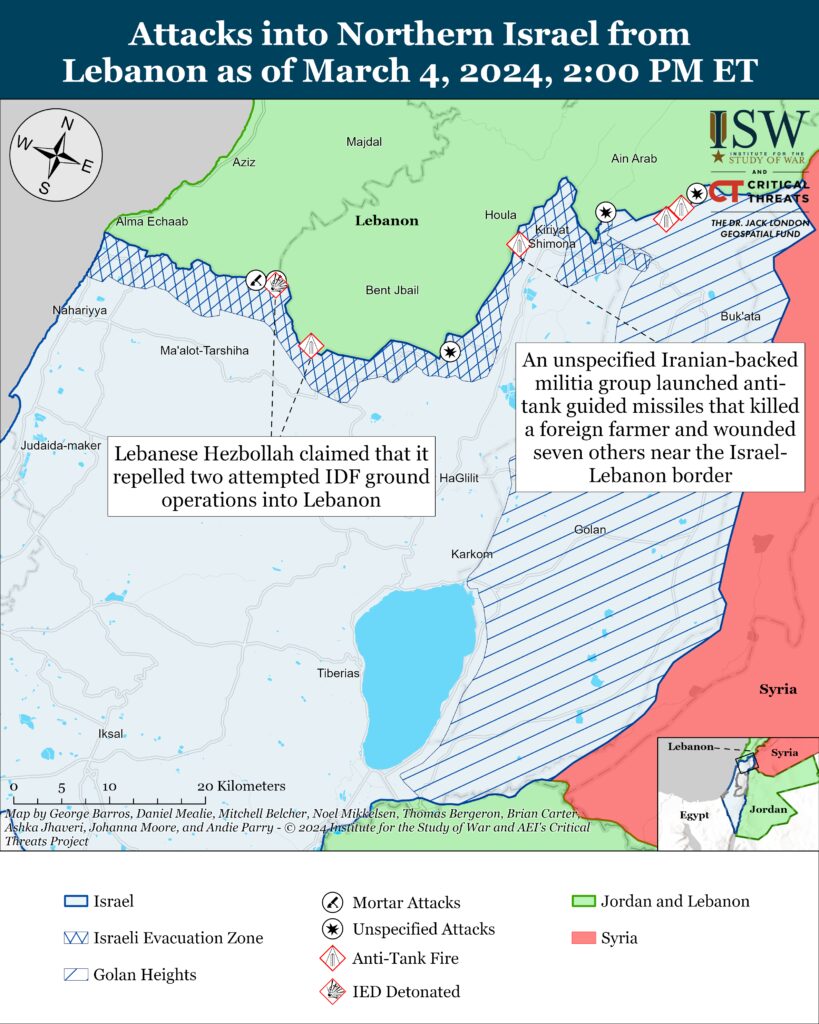
Recorded reports of attacks; CTP-ISW cannot independently verify impact.
Iran and Axis of Resistance
Axis of Resistance campaign objectives:
Demonstrate the capability and willingness of Iran and the Axis of Resistance to escalate against the United States and Israel on multiple fronts
Set conditions to fight a regional war on multiple frontsFormer Iraqi Parliament Speaker Mohammad al Halbousi discussed unspecified bilateral cooperation with US Ambassador to Iraq Alina Romanowski and other US officials on March 4.[xlviii] Halbousi previously met with Romanowski on February 22 to discuss the US military presence in Iraq and the status of the US-led coalition mission to defeat ISIS.[xlix] Halbousi has previously indicated opposition to the Iranian-backed effort to expel US forces from Iraq.[l]
The Iraqi Federal Supreme Court removed Halbousi from his role as parliamentary speaker in November 2023 on charges of abusing power and violating his oath of office.[li] Halbousi claimed that the ruling was unconstitutional and meant to create political divisions within society.[lii] Halbousi‘s expulsion from Parliament may have removed an obstacle for Iranian-backed actors to advance anti-US legislation and resolutions as CTP-ISW previously reported.[liii]
The Houthis launched anti-ship missiles that damaged the Liberian-flagged MSC Sky II commercial vessel in the Gulf of Aden on March 4.[liv] The UK Maritime Trade Operations Authority reported that one of two missiles impacted Sky II and set fire to the ship.[lv] The crew later brought the fire under control, and the Sky II proceeded under its own power to its next port of call.[lvi]
The Houthi military spokesperson claimed that the group launched an unspecified number of anti-ship ballistic missiles and drones targeting US warships in the Red Sea on March 4.[lvii] Houthi-affiliated media claimed that the United States and United Kingdom conducted three airstrikes in northern Yemen on March 4.[lviii] US CENTCOM has not claimed any airstrikes or acknowledged the Houthi’s claimed attack on US warships at the time of this writing.
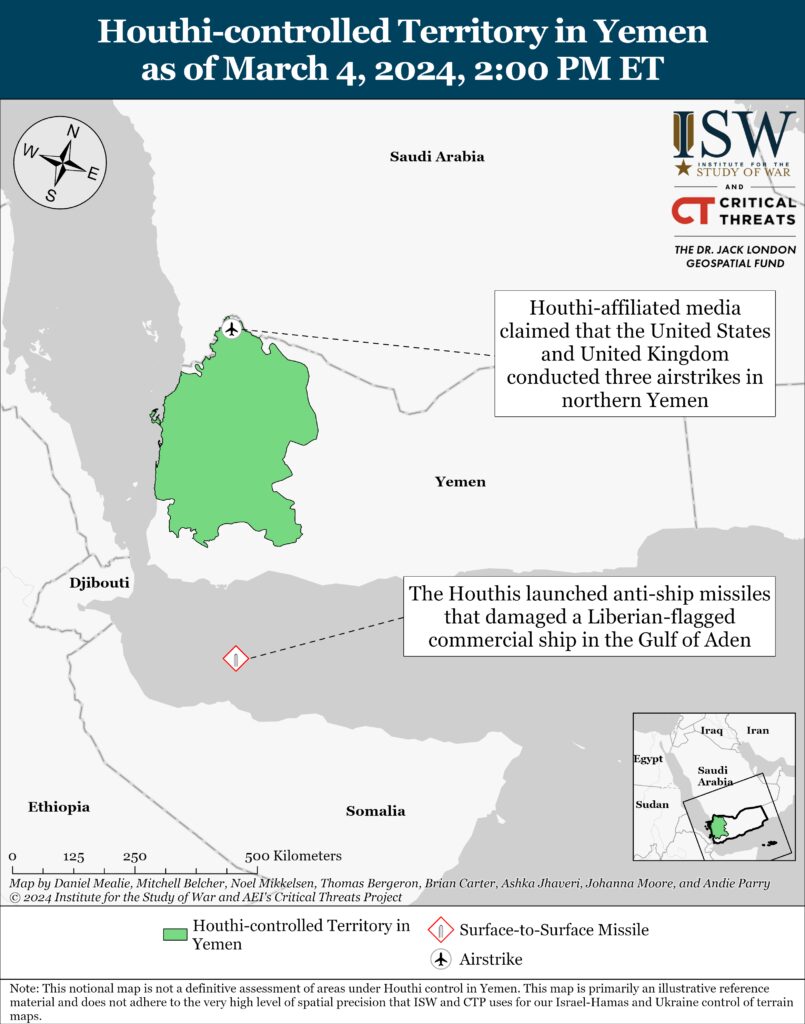
The Iranian defense minister discussed the Israel-Hamas war with his Qatari counterpart in Doha on March 4.[lix] The Iranian defense minister is there to attend the 8th Doha International Maritime Defense Exhibition and Conference. The Iranian foreign affairs minister recently discussed a potential Israel-Hamas ceasefire, an exchange of prisoners, and the delivery of humanitarian aid to the Gaza Strip with the Qatari prime minister on March 1.[lx]
The Iranian judiciary executed an alleged Israeli Mossad-affiliated individual on March 3 for allegedly aiding Israeli sabotage of Iranian defense ministry facilities in January 2023.[lxi] The Iranian judiciary accused the individual of transporting Israeli drones into Iran for the purpose of striking Defense Ministry facilities in Esfahan.[lxii] The Esfahan provincial chief justice claimed that Intelligence and Security Ministry and IRGC Intelligence Organization agents apprehended the individual.[lxiii] Israel conducted a one-way drone attack on a military munitions factory near Esfahan City, Esfahan Province on January 28, 2023.[lxiv] The Defense Ministry reportedly uses the targeted facility to produce ballistic missiles and drones.[lxv]
 Eurasia Press & News
Eurasia Press & News
